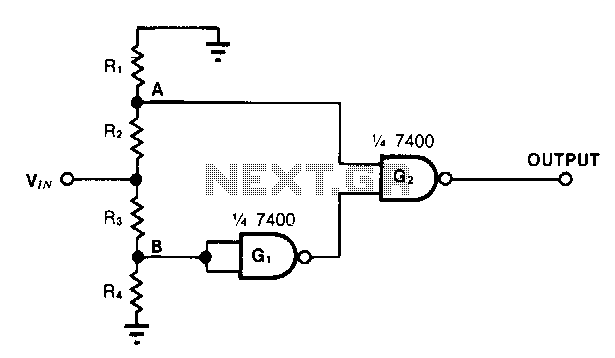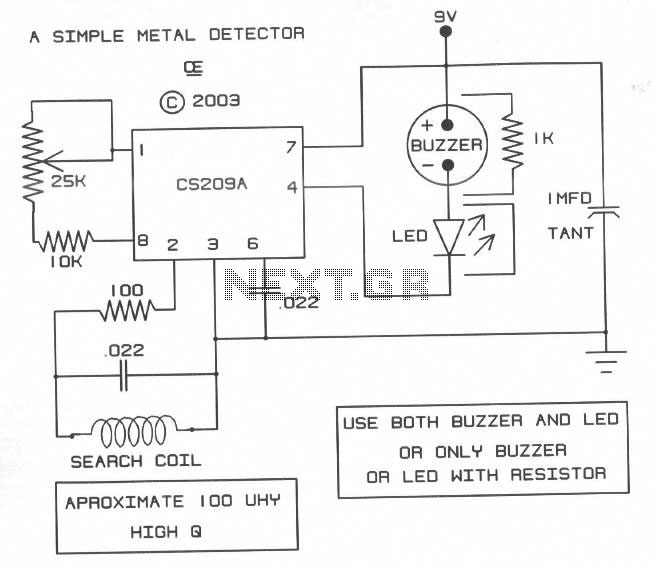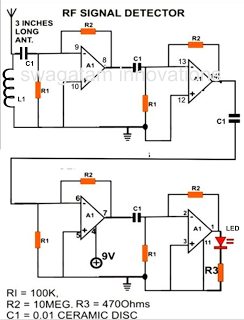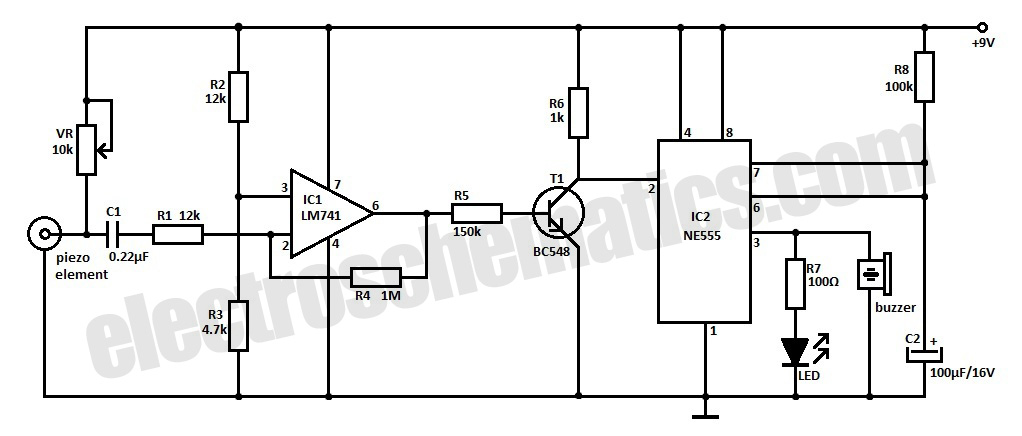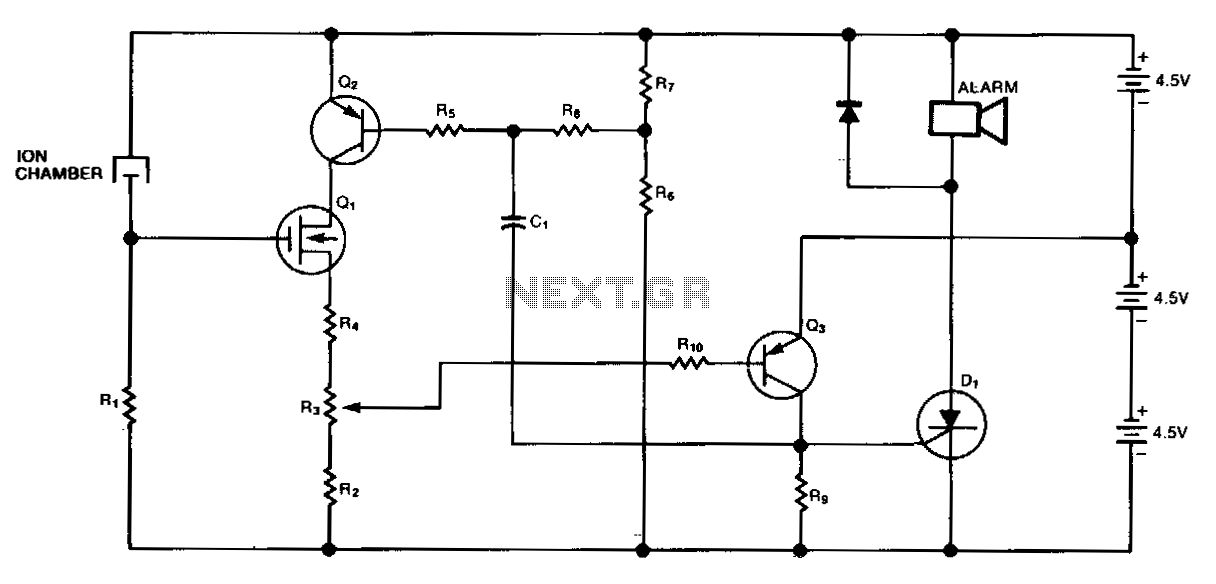
Full-Cup Detector For The Blind
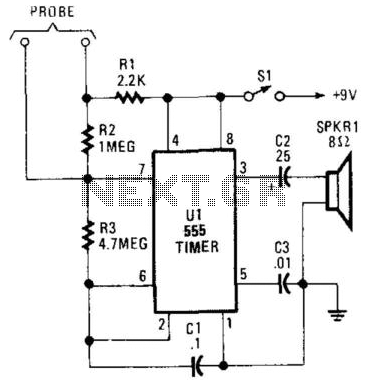
The Full-Cup Detector utilizes a 555 oscillator/timer configured to generate a 15 Hz clicking sound until its probe contacts are bridged. At that point, the output frequency increases to approximately 500 Hz. This device is designed to assist visually impaired individuals in determining when a cup or bowl is filled with liquid, such as coffee or soup. The NE555 timer produces ticks at a frequency of 15 Hz. A set of probes (such as wires) is positioned within the container at a predetermined level. When the liquid level makes contact with the probes, the clicking frequency rises to several hundred hertz, which varies based on the liquid's conductivity.
The Full-Cup Detector circuit is built around the NE555 timer, a versatile integrated circuit commonly used in various timing applications. The circuit operates in astable mode, where it continuously switches between high and low states, generating a square wave output. The frequency of the output signal is determined by the resistor and capacitor values connected to the 555 timer.
In this application, the NE555 is configured with specific resistors (R1 and R2) and a capacitor (C1) that establish the initial frequency of 15 Hz. The resistors are selected to set the timing interval, while the capacitor charges and discharges through these resistors, producing the desired frequency.
The probes used in the circuit are strategically placed at the liquid level within the container. When the liquid rises and bridges the probes, it completes the circuit, causing a significant change in the output frequency. This change is due to the alteration in the resistance and capacitance values introduced by the conductive liquid, which affects the timing characteristics of the 555 timer.
As a result, the output frequency increases to around 500 Hz, providing an audible indication that the container is full. The higher frequency is easily distinguishable from the initial 15 Hz clicks, allowing users to quickly recognize when to stop pouring. The circuit can be powered by a standard battery, making it portable and convenient for everyday use.
This Full-Cup Detector circuit serves as an effective tool for visually impaired individuals, enhancing their independence and safety in daily activities involving liquids. At the heart of the Full-Cup Detector is a 555-oscillator/timer configured to produce a 15-Hz click, until its probe contacts are bridged, at which time its output frequency goes to about 500 Hz. This circuit can be used by the visually handicapped to determine when a cup or bowl is full of liquid (coffee, soup, etc). Ul, an NE555, produces ticks at 15 Hz. A set of probes (wire, etc.) is placed in the container at the desired level. When the liquid level contacts the probes, the frequency of clicks increases to several hundred hertz, depending on its conductivity.
The Full-Cup Detector circuit is built around the NE555 timer, a versatile integrated circuit commonly used in various timing applications. The circuit operates in astable mode, where it continuously switches between high and low states, generating a square wave output. The frequency of the output signal is determined by the resistor and capacitor values connected to the 555 timer.
In this application, the NE555 is configured with specific resistors (R1 and R2) and a capacitor (C1) that establish the initial frequency of 15 Hz. The resistors are selected to set the timing interval, while the capacitor charges and discharges through these resistors, producing the desired frequency.
The probes used in the circuit are strategically placed at the liquid level within the container. When the liquid rises and bridges the probes, it completes the circuit, causing a significant change in the output frequency. This change is due to the alteration in the resistance and capacitance values introduced by the conductive liquid, which affects the timing characteristics of the 555 timer.
As a result, the output frequency increases to around 500 Hz, providing an audible indication that the container is full. The higher frequency is easily distinguishable from the initial 15 Hz clicks, allowing users to quickly recognize when to stop pouring. The circuit can be powered by a standard battery, making it portable and convenient for everyday use.
This Full-Cup Detector circuit serves as an effective tool for visually impaired individuals, enhancing their independence and safety in daily activities involving liquids. At the heart of the Full-Cup Detector is a 555-oscillator/timer configured to produce a 15-Hz click, until its probe contacts are bridged, at which time its output frequency goes to about 500 Hz. This circuit can be used by the visually handicapped to determine when a cup or bowl is full of liquid (coffee, soup, etc). Ul, an NE555, produces ticks at 15 Hz. A set of probes (wire, etc.) is placed in the container at the desired level. When the liquid level contacts the probes, the frequency of clicks increases to several hundred hertz, depending on its conductivity.
